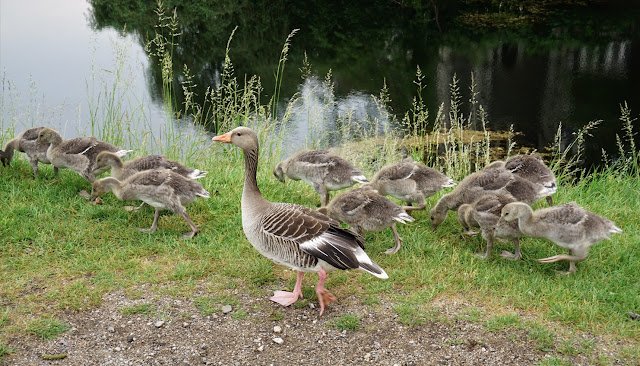Our last full day in Copenhagen ahead of our embarkation for our Baltic cruise was another busy day. We started with more of a walkabout to some of the locations that we had either missed, or didn't have time for the day before. This took us to the large domed church, the old Kastellet, a Star-shaped 17th-century fortress with ramparts & a museum then on to the Rosenborg Castle. We grabbed a quick lunch then met the rest of our gang for a canal boat tour. This was a great way to experience more of the city, along with commentary and a different "angle" on some of the sites we'd see earlier. After our canal tour, we went on another guided walking tour, this one on and about the manmade island of Christianshavn, ending with an unguided walk around the self-governed Freetown Christiania. For dinner that night, a bunch of us went out and brought back some really good prepared salads from the supermarket. We had a great time dining together and visiting. Tomorrow we planned to do a little more sight-seeing before heading off to the ship.

Frederik's Church, an 18th-century Lutheran church with the largest dome in Scandinavia.

The domed ceiling of Frederik's Church.

Beautiful old organ in the (unusually) round marble church.

Art shot through one of the old glass windows. I don't recall there being any stained glass in this church, only clear glass windows. We didn't go into any other Lutheran churches in Denmark, maybe the lack of stained glass is the norm for Lutheran churches.

Entrance to the Kastellet (or Citadel in english). The area was renovated in the 1980's, but the original structure dates back to the 1600's.

The pentagonal Kastellet is surrounded by ramparts like these, with a moat on the inside and the ocean on the outside.

The last working windmill of the ramparts that once surrounded all of Copenhagen. There used to be many windmills, but there are just two remaining. This was originally used to mill flour.

There were several families of geese that made the Kastellet their home.

St. Alban's Anglican Church, just outside the grounds of the Kastellet. It was built in the late 1800's to support the growing English population of Copenhagen.

Inside St. Alban's Church (with stained glass windows and a pretty large pipe organ, given the size of the small church).

Walking through one of the more colourful neighbourhoods of Copenhagen. Not all the areas were like this, in fact some of the buildings were very plain and unadorned, with little to distinguish them from each other.

The gardens and grounds of Rosenborg Castle, originally built as a country summerhouse for the royal family in 1606.

The eastern view of the Rosenborg Castle.

Statue of Queen Caroline Amalie in the gardens of the castle.

Sights from our canal boat tour. This is "The Standard", formerly a customs house for the port, now home to a couple of restaurants.

The Danish Royal Yacht, built in 1930 and still used by the Royal Family.

A shot of Frederik's Church in the background and the buildings of the Amalienborg Royal Palace in the foreground.

The canal view of what we had seen the day before, with the new metro line construction on either side.

On our afternoon walking tour, the guide pointed out his "favourite" statue, which is actually underwater in one of the canals - we never would have noticed it otherwise. This bronze installation portrays "a merman and his seven sons with outstretched arms, begging Agnete to return home" and is based on a Danish fairytale.

The former Stock Exchange building. The black grime on the outside is from modern traffic.

On the man-made island of Christianshavn. You can see by the windows of the grey building, some structures are suffering from the unstable ground.

Some of the more colourful buildings in Christianshavn.

"Vor Frelsers Kirke is a baroque church...most famous for its helix spire with an external winding staircase that can be climbed to the top... It is also noted for its carillon, which is the largest in northern Europe and plays melodies every hour from 8 am to midnight." We didn't climb to the top, but the guide did arrange that we would be there to hear the lovely carillon music.

This is "Lille Mølle (Little Mill in English) an historic house museum in the Christianshavn neighbourhood. It was the last windmill on the old ramparts of Christianshavn. It is a Dutch smock mill erected in 1783...replacing a post mill built in 1669. It was turned into a private home in 1916." And is no longer open to the public. So we just looked and took pictures of the private residence.

After our tour of the "autonomous anarchist district" of Christiania, Copenhagen's "alternative neighbourhood", we walked through this gate, back into the E.U. The area is left by the city to be self-governing. Our guide (who did not accompany us into the area) advised us not to take pictures. Although the cannabis trade is tolerated, narcotics are not (but they can still be had here), so residents of the area would not want their pictures taken. In fact, there had been a few raids the day before when some other people from our group had toured the area. There were a lot of booths set up selling all kinds of marijuana products. Kind of like the Robson Street mall in downtown Vancouver.
NEXT: (Day 4) Copenhagen, Denmark - Embarkation
PREV: (Day 2) Copenhagen, Denmark - Day 2
Baltic Cruise - May-June 2018